Eastern Mediterranean University Urban Research and Development Center (EMU-URDC) Executive Board Member and EMU Faculty of Architecture academic staff member Assoc. Prof. Dr. Ege Uluca Tümer released a statement on the rehabilitation of Kyrenia Harbour Street. The statement reads as follows:
The rehabilitation of historic streets has been the subject of many international regulations since the 1970s, when historical environments became more prominent as protected areas, and many implementation projects were carried out in this area in the world. The first of the two main issues in these projects is to research and understand the past periods of these areas/streets in detail, and to develop all kinds of interventions and design proposals based on these researches. The second issue is the typological analysis of the original designs, details and materials in the area/street, and the use of designs, details and materials suitable for these typologies and physically and visually compatible with the area in the entire area. Of course, these studies can be carried out by expert teams by completing certain stages (research of printed and visual documents, archive scans, field studies, evaluation processes).
However, we have observed that the rehabilitation of Kyrenia Harbour Street, which is one of the most important values of the historical heritage of Cyprus, is carried out by excluding scientific studies and knowledge in this field, as if there is no science and expertise related to these processes and protection-restoration defined all over the world.
Unfortunately, the fact that the administrators in Northern Cyprus do not give importance to science, expertise and scientists harms our society, our island, our future generations and brings with it irreversible mistakes. We are experiencing a very negative example of this in the Kyrenia Harbour Street rehabilitation process.
Today, carrying out the conservation-restoration-design processes in the aforementioned historical environment in cooperation with the Eastern Mediterranean University 'Conservation and Restoration' Master's Program - the only one the island, could have brough along a much more scientific and internationally-based practice; the fact that this method is not preferred has now irreversible results in this important historical area, which has cultural heritage value.
First of all, the so-called rehabilitation project does not have a ‘project owner’, or it is not specified anywhere. This makes it impossible to properly discuss the scientific restoration principles and design criteria of the project being implemented. It is seen that the resulting implementation is far from revealing the original layers of the facades and coatings of the historical buildings in Kyrenia Harbour Street and completing the missing parts in accordance with the original. This approach causes the existing texture, materials and details to lose their originality, and it is probably a sign that we will encounter many more applications that are against scientific restoration rules when this work is finished.
However, it is possible to avoid all these mistakes with ‘project teams with many decision makers’, ‘consultants and supervisors with conservation and restoration expertise’ and ‘participatory processes’, which are advocated for such important projects in all international statutes. It is regrettable for us to see that many more valuable cultural heritage sites and structures will continue to suffer irreversible damage until such a tradition and approach develops in our country”.







